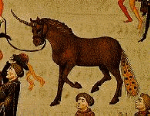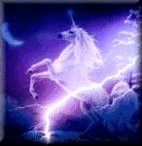
The Origin of the Unicorn
This is the most technical, yet curiously interesting information on the origin of the Unicorn I have found so far. And with the introduction of fossils, definitely the most believable.It is said that contrary to popular belief, Unicorns did not evolve from horse like ancestors. Instead they are descendants of cloven-hoofed mammals such as pigs, camels, deer, and antelope. This is believed because unicorns have cloven hooves and have true horns, which you will find on no horse, only cloven-hoofed animals. To narrow down their "relatives" even more, we can say that they are more likely to be related to antelope as opposed to deer because of the horn. Deer antlers are similar to bone structures that grow out of the males (generally) forehead in the spring and summer. The antlers are then shed for the winter months. Now, the horns found in antelope, cattle and sheep are never shed and continue to grow throughout the animals' lifetime. Also, both sexes typically grow horns where as only the buck (male deer) grows antlers.
With this information in mind, I would like to introduce some of the earliest encounters with Unicorns. Beginning with the Asian encounters we shall see what has happened to them through the ages. Look into these recordings and see what history shows us of how they may have evolved into the greatly loved fantasy creature we know of today.

Unicorns in Chinese History
Another form of the unicorn can be found in East Asia. In China k'i-lin (with k'i for the male and "lin" for the female part) was honored as the king of the land animals. Because of its strength and wisdom you could compare it with the Chinese dragon and it was also seen as representation of compassion and the love of peace. The k'i-lin is often shown with fish scales that shimmer in every colour of the rainbow. This unicorn brought important messages to human beings and it was seen in 2697 BC for the first time as it wandered through the palace of the emperor Huang-ti. This was seen as the announcement of lucky years.

Unicorn Encounters in East Asia
- Huang Ti

- The K'i-lin (Unicorn) was seen by Huang Ti (the Yellow Emperor) for the first time in 2697 BC, as it wandered through the palace. People say that in the following years shortly after the unicorn encounter, Huang-Ti went on to invent musical instruments, taught his people how to build houses with bricks and united the Chinese tribes for the first time. The K'i-lin showed itself to the emperor at the end of his life for a second time. He saw the unicorn standing in his gardens. The animal called out to him softly as he just stared in admiration of the creature. Soon afterwards Huang Ti died and it was believed that his spirit was carried into eternity by K'i-lin.
- Yen Tschen-Tsai
- It is also written that the k'i-lin appeared in the 6th century BC in a temple in front of a young woman called Yen Tschen-Tsai and that it showed her with a jade plate that she would give birth to a "king without throne". Although the woman tried to hold the unicorn with a rope of silk the k'i-lin simply bowed and vanished again. The son that was later born by that woman, Konfuzius, created some years later with his teaching that system of order which has influenced the Chinese politics and philosophers for centuries.
- Fu Hsi

- Twenty-eight years before the birth of Christ, the Chinese emperor Fu Hsi, gazed at a unicorn that stood near the bank of the Yellow River. The unicorn was the size of a calf with a silvery multi-colored horn with spots upon its back. As it disappeared into the distance Fu Hsi followed after it only to suddenly realize that such marring could show ideas and words, thus the unicorn was responsible for the introduction of a written Chinese language.

Unicorn Encounters in the Past
- Gaius Iulius Cesar
- One of the first reports of the existence of the unicorn in Europe is read by almost every Latin student in school. The later emperor of the Roman empire Gaius Iulius Cesar mentioned it in the "Bellum Gallicum" 50 BC :"It looks like a deer with a single horn on the middle of its fore-head right between its ears. This horn is longer and straighter than any horn we know of..."
- Genghis Khan
- While marching through many mountain passes on his way to conquer India, Genghis Khan, beheld a unicorn came running toward him. Upon its arrival before Kahn, the unicorn bent its knee three times in token of reverence. Seeing this, Khan decided against taking India and marched his army back onto his own land.
- Daniel
- There is a dream relating to a unicorn written in the book of Daniel. In the description of the dream, Daniel was at the River Ulai and by it's bank stood a ram with two horns, one slightly larger than the other. As it stood there it grew in size each time it breathed in. Then a unicorn appeared and it was shaped like a goat, complete with the beard, with eyes of deep red in rage. The unicorn fell into combat with the ram and, using it's longer, sword-like horn, knocked the ram into the water where crimson soon after surfaced. After that the unicorn, horn tipped with blood, began growing in size and the horn fell off, and was replaced by four smaller horns. Out of the horns grew more and more horns until finally they touched the heavens and stars plummeted in a veil of sparks. The ground was covered heavily with the dust of comets.
- Alexander the Great

- The horse of Alexander the Great "Bukephalos", was described as "an incredible huge horse with the great ivory horn of a unicorn and the tail of a peacock". This creature was a present from the Egyptian queen on the day of his birth. No one was able to ride Bukephalos besides Alexander himself. Alexander had became one of the greatest conqueror of human history and it is written that before Bukephalos died he built an entire city, in honor of his loyal horse.
- Ctesias
- After serving the King of Persia, Ctesias returned to his native land of Greece. There he began writings of the strange creatures he had seen in his travels, one of them being our beloved unicorn. Ctesias described the creature as having a foot and a half long, red, white, black horn (red at tip, black at middle, white at bottom) as well as its head being red and the rest of its body being white, with eyes of blue. It is now believed, however, that Ctesias saw just a rhinoceros, not the magical creature he believed he had seen.


The Unicorn in Medieval Lore
In medieval times, the magical power of the Unicorns horn was still believed in. A powder made from this horn was supposed to neutralize any kind of poison and the horn itself was said to bleed when poisoned food was brought near it. As a consequence of this, in these "glorious days" of assassins and intrigants the horn of a unicorn was highly desired by noble men and rulers. In the 15th century 40.000 gold pieces not an uncommon price offered for one. (The actual horn, that was offered, often was the horn of the narwhale (lat.: monodom monoceros), which is also called "unicorn of the sea".) The healing power of its horn, was supposed to have made the unicorn a symbol of medicine. Even today you may find quite a lot old medicine stores with the picture or the name of the Unicorn.


|

|


|